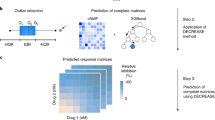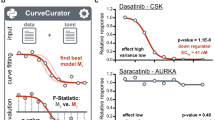Abstract
We describe a protocol for the discovery of synergistic drug combinations for the treatment of disease. Synergistic drug combinations lead to the use of drugs at lower doses, which reduces side effects and can potentially lead to reduced drug resistance, while being clinically more effective than the individual drugs. To cope with the extremely large search space for these combinations, we developed an efficient combinatorial drug screening method called the Feedback System Control (FSC) technique. Starting with a broad selection of drugs, the method follows an iterative approach of experimental testing in a relevant bioassay and analysis of the results by FSC. First, the protocol uses a cell viability assay to generate broad dose-response curves to assess the efficacy of individual compounds. These curves are then used to guide the dosage input of each drug to be tested in combination. Data from applied drug combinations are input into the differential evolution (DE) algorithm, which predicts new combinations to be tested in vitro. This process identifies optimal drug-dose combinations, while saving orders of magnitude in experimental effort. The complete optimization process is estimated to take ∼4 weeks. FSC does not require insight into the disease mechanism, and it has therefore been applied to find combination therapies for many different pathologies, including cancer and infectious diseases, and it has also been used in organ transplantation.
This is a preview of subscription content, access via your institution
Access options
Subscribe to this journal
Receive 12 print issues and online access
$259.00 per year
only $21.58 per issue
Buy this article
- Purchase on Springer Link
- Instant access to full article PDF
Prices may be subject to local taxes which are calculated during checkout





Similar content being viewed by others
References
Sawyers, C.L. Cancer: mixing cocktails. Nature 449, 993–996 (2007).
De Francesco, R. & Migliaccio, G. Challenges and successes in developing new therapies for hepatitis C. Nature 436, 953–960 (2005).
Lehar, J. et al. Synergistic drug combinations tend to improve therapeutically relevant selectivity. Nat. Biotechnol. 27, 659–666 (2009).
Lindsay, M.A. Target discovery. Nat. Rev. Drug Discov. 2, 831–838 (2003).
Forrest, S. Genetic algorithms: principles of natural selection applied to computation. Science 261, 872–878 (1993).
Bonabeau, E., Dorigo, M. & Theraulaz, G. Inspiration for optimization from social insect behaviour. Nature 406, 39–42 (2000).
Al-Shyoukh, I. et al. Systematic quantitative characterization of cellular responses induced by multiple signals. BMC Syst. Biol. 5, 88 (2011).
Wang, H. et al. Mechanism-independent optimization of combinatorial nanodiamond and unmodified drug delivery using a phenotypically driven platform technology. ACS Nano 9, 3332–3344 (2015).
Ding, X., Xu, H., Hopper, C., Yang, J. & Ho, C.M. Use of fractional factorial designs in antiviral drug studies. Qual. Reliab. Eng. Int. 29, 229–304 (2013).
Honda, Y. et al. Guiding the osteogenic fate of mouse and human mesenchymal stem cells through feedback system control. Sci. Rep. 3, 3420 (2013).
Sun, C.P. et al. Integrative systems control approach for reactivating Kaposi's sarcoma-associated herpesvirus (KSHV) with combinatory drugs. Integr. Biol. (Camb) 1, 123–130 (2009).
Tsutsui, H. et al. An optimized small molecule inhibitor cocktail supports long-term maintenance of human embryonic stem cells. Nat. Commun. 2, 167 (2011).
Weiss, A. et al. A streamlined search technology for identification of synergistic drug combinations. Sci. Rep. 5, 14508 (2015).
Weiss, A. et al. Rapid stochastic optimization of drug combination for inhibiting angiogenesis in cancer growth. Angiogenesis 9462, 233–244 (2015).
Wong, P.K. et al. Closed-loop control of cellular functions using combinatory drugs guided by a stochastic search algorithm. Proc. Natl. Acad. Sci. USA 105, 5105–5110 (2008).
Yoon, B.J. Enhanced stochastic optimization algorithm for finding effective multi-target therapeutics. BMC Bioinformatics 12 (suppl. 1): S18 (2011).
Yu, F. et al. Control of Kaposi's sarcoma-associated herpesvirus reactivation induced by multiple signals. PLoS ONE 6, e20998 (2011).
Ding, X. et al. Cascade search for HSV-1 combinatorial drugs with high antiviral efficacy and low toxicity. Int. J. Nanomed. 7, 2281–2292 (2012).
Yu, H. et al. Optimizing combinations of flavonoids deriving from astragali radix in activating the regulatory element of erythropoietin by a feedback system control scheme. Evid. Based Complement. Altern. Med. 2013, 541436 (2013).
Storn, R.M. & Price, K.V. Differential evolution—a simple and efficient heuristic for global optimization over continuous spaces. J. Global Optim. 11, 341–359 (1997).
Das, S. & Suganthan, P.N. Differential evolution: a survey of the state-of-the-art. IEEE Trans. Evol. Comput. 15, 4–31 (2011).
Chakraborty, U.K. Advances in Differential Evolution (Springer Verlag, 2008).
Yoon, H. et al. Modeling to predict growth/no growth boundaries and kinetic behavior of Salmonella on cutting board surfaces. J. Food Prot. 75, 2116–2121 (2012).
Van der Borght, K. et al. Cross-validated stepwise regression for identification of novel non-nucleoside reverse transcriptase inhibitor resistance associated mutations. BMC Bioinformatics 12, 386 (2011).
Wood, K., Nishida, S., Sontag, E.D. & Cluzel, P. Mechanism-independent method for predicting response to multidrug combinations in bacteria. Proc. Natl. Acad. Sci. USA 109, 12254–12259 (2012).
Seber, G.A.F. & Lee, A.J. Linear Regression Analysis 2nd edn (Wiley, 2003).
Chou, T.C. Drug combination studies and their synergy quantification using the Chou-Talalay method. Cancer Res. 70, 440–446 (2010).
Feala, J.D. et al. Systems approaches and algorithms for discovery of combinatorial therapies. Wiley Interdiscip. Rev. Syst. Biol. Med. 2, 181–193 (2010).
Dancey, J.E. & Chen, H.X. Strategies for optimizing combinations of molecularly targeted anticancer agents. Nat. Rev. Drug Discov. 5, 649–659 (2006).
Park, M., Nassar, M. & Vikalo, H. Bayesian active learning for drug combinations. IEEE Trans. Biomed. Eng. 60, 3248–3255 (2013).
Decker, S. & Sausville, E.A. Preclinical modeling of combination treatments: fantasy or requirement? Ann. NY Acad. Sci. 1059, 61–69 (2005).
Tol, J. et al. Chemotherapy, bevacizumab, and cetuximab in metastatic colorectal cancer. N. Engl. J. Med. 360, 563–572 (2009).
Jia, J. et al. Mechanisms of drug combinations: interaction and network perspectives. Nat. Rev. Drug Discov. 8, 111–128 (2009).
Calzolari, D. et al. Search algorithms as a framework for the optimization of drug combinations. PLoS Comput. Biol. 4, e1000249 (2008).
Zimmermann, G.R., Lehar, J. & Keith, C.T. Multi-target therapeutics: when the whole is greater than the sum of the parts. Drug Discov. Today 12, 34–42 (2007).
Borisy, A.A. et al. Systematic discovery of multicomponent therapeutics. Proc. Natl. Acad. Sci. USA 100, 7977–7982 (2003).
Lamb, J. et al. The Connectivity Map: using gene-expression signatures to connect small molecules, genes, and disease. Science 313, 1929–1935 (2006).
Potti, A. et al. Genomic signatures to guide the use of chemotherapeutics. Nat. Med. 12, 1294–1300 (2006).
Lehar, J. et al. Chemical combination effects predict connectivity in biological systems. Mol. Syst. Biol. 3, 80 (2007).
Nelander, S. et al. Models from experiments: combinatorial drug perturbations of cancer cells. Mol. Syst. Biol. 4, 216 (2008).
Zhao, B., Hemann, M.T. & Lauffenburger, D.A. Intratumor heterogeneity alters most effective drugs in designed combinations. Proc. Natl. Acad. Sci. USA 111, 10773–10778 (2014).
Gamperle, R.M., Sibylle, D. & Koumoutsakos, P. A Parameter Study for Differential Evolution. in Advances in Intelligent Systems, Fuzzy Systems, Evolutionary Computation (eds. Grmela, N. & Mastorakis, A.) 293–298 (WSEAS Press, 2002).
Ding, X. et al. Discovery of a low-order drug-cell response surface for applications in personalized medicine. Phys. Biol. 11, 065003 (2014).
Tallarida, R.J. Drug synergism: its detection and applications. J. Pharmacol. Exp. Ther. 298, 865–872 (2001).
Minto, C.F. et al. Response surface model for anesthetic drug interactions. Anesthesiology 92, 1603–1616 (2000).
Price, K.V., Storn, R.M. & Lampinen, J.A. Differential Evolution: A Practical Approach to Global Optimization (Springer, 2005).
Storn, R.M. Differential Evolution (DE) http://www1.icsi.berkeley.edu/~storn/code.html.
Acknowledgements
C.-M.H. acknowledges the support from the Ben Rich-Lockheed Martin Professor Endowment Fund and the Bill and Melinda Gates Foundation. P.N.-S. and A.W.G. acknowledge the support of KWF, the Dutch Cancer Society (Project VU 2014-7234). The authors acknowledge EPFL for financial support. We appreciate A.M. Silva for providing the sketch for Figure 2.
Author information
Authors and Affiliations
Contributions
P.N.-S. conceived and designed the protocol, and wrote the manuscript; X.D. designed the protocol, modeled the data, delivered the code and wrote the manuscript; A.W. designed the protocol, delivered the code and wrote the manuscript; C.-M.H. conceived the FSC technology and participated in data modeling, data interpretation and writing of the manuscript; P.J.D. participated in data interpretation and writing of the manuscript; H.v.d.B. initiated the collaboration and participated in data interpretation, and in writing of the manuscript; A.W.G. designed the study, participated in data interpretation and contributed to writing of the manuscript. All authors read and approved the final manuscript.
Corresponding authors
Ethics declarations
Competing interests
All authors are the co-inventors on the FSC-related patents.
Supplementary information
Supplementary Text and Figures
Supplementary Note and Supplementary Tutorial (PDF 220 kb)
Supplementary Data
Example dataset for the refined search, providing an example of regression analysis performed in MATLAB. (XLS 111 kb)
Rights and permissions
About this article
Cite this article
Nowak-Sliwinska, P., Weiss, A., Ding, X. et al. Optimization of drug combinations using Feedback System Control. Nat Protoc 11, 302–315 (2016). https://doi.org/10.1038/nprot.2016.017
Published:
Issue Date:
DOI: https://doi.org/10.1038/nprot.2016.017
This article is cited by
-
Network-informed discovery of multidrug combinations for ERα+/HER2-/PI3Kα-mutant breast cancer
Cellular and Molecular Life Sciences (2023)
-
Pathological angiogenesis: mechanisms and therapeutic strategies
Angiogenesis (2023)
-
Anti-angiogenic agents — overcoming tumour endothelial cell anergy and improving immunotherapy outcomes
Nature Reviews Clinical Oncology (2021)
-
Application of lung microphysiological systems to COVID-19 modeling and drug discovery: a review
Bio-Design and Manufacturing (2021)
-
Forcing dividing cancer cells to die; low‐dose drug combinations to prevent spindle pole clustering
Apoptosis (2021)
Comments
By submitting a comment you agree to abide by our Terms and Community Guidelines. If you find something abusive or that does not comply with our terms or guidelines please flag it as inappropriate.



